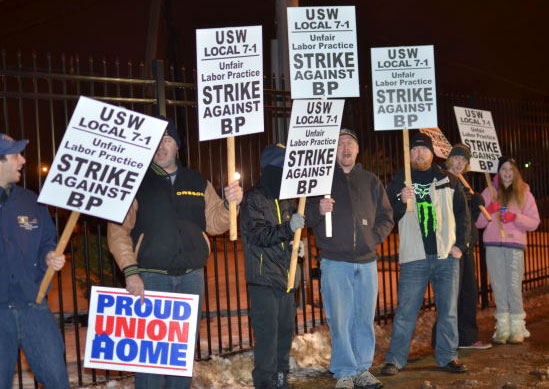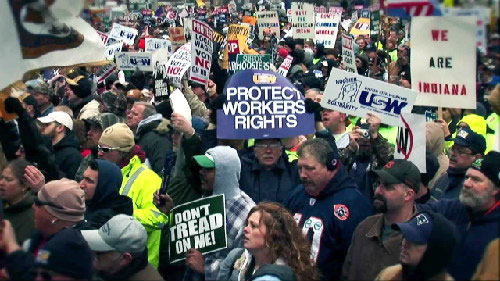LACMA, BP & the Oil Workers Strike
On February 1, 2015, 4,000 workers belonging to the United Steelworkers Union (USW), walked off their jobs at nine oil refinery and chemical plants across the US. By Feb. 10 another 1,400 workers went on strike at two refineries in Indiana and Ohio. The strike now effects 11 oil refinery and chemical plants used by BP, Shell, ExxonMobil, Marathon Petroleum, and Lyondell Basell, including those in California, Kentucky, Texas, and Washington. The USW represents 30,000 workers that run more than 200 refineries, terminals, and pipelines. The number of workers on strike and on the picket line is over 5,000… so far.

The workers are striking because of unsafe and dangerous working conditions. Their grievances include a stop to “daily occurrences of fires, leaks, emissions, and explosions, brutal and dangerous scheduling practices,” as well as layoffs, speed-ups, and the hiring of inexperienced non-union labor.
The strike kicked-off when talks collapsed with Shell Oil, which is leading the industry-wide negotiations. BP and the other oil companies are now hiring scab labor to keep their operations going.
The work stoppage is the largest nationwide strike in the US since 1980. Addressing the public and fellow workers both unionized and non-unionized, the strikers made it clear that “138 workers were killed on the job while extracting, producing, or supporting oil and gas in 2012,” a number “more than double” the fatalities suffered in 2009. The workers charge BP and the other oil giants with cutting back on safety protocols and intensifying layoffs and speed-ups to keep profits high. Here it should be remembered that 11 workers were killed when BP’s Deepwater Horizon oil rig exploded and sank into the Gulf of Mexico on April 20, 2010.
But what does any of this have to do with the Los Angeles Country Museum of Art (LACMA)?
I have been writing in opposition to oil giant BP funding LACMA since the oily relationship was publicly announced in June of 2007. I wrote the following in a June 2010 blog post. It is a fair summation of my stance regarding LACMA director and CEO Michael Govan enthusiastically accepting money from BP; which he said was committed “to sustainable energy.”
“In 2007 Mr. Govan accepted $25 million from the oil company and in return the museum built the so-called ‘BP Grand Entrance’ on the LACMA campus. Every time an artist or arts group presents works beneath the BP Grand Entrance, it lends authority, respectability, and quiet approval to the machinations of one of the world’s biggest polluters; even if that presentation is of a ‘challenging’ nature – it nonetheless enables BP to present itself as a generous and ‘socially responsible’ supporter of the arts. As one must pass through the BP Grand Entrance in order to enter the LACMA museum complex, BP has succeeded in placing its imprimatur upon every LACMA exhibit, not to mention its entire collection.”
I always viewed LACMA’s relationship with BP as an ethical dilemma for the arts community, from BP shaping an arts institution to LACMA being a partner in the oil giant’s “greenwashing” propaganda. However, the nationwide workers’ strike against BP adds a new wrinkle to the entanglement – revealing once more the difficult interface between art and capitalism.

If thousands of workers are on strike against BP because of deplorable working conditions that are literally taking workers’ lives, and BP is a major contributor to LACMA… what then does that make the museum? Is it really an impartial institution? Does it actually need to be said which side LACMA is on – with the workers, their families and friends – or with BP? Can Michael Govan and LACMA really tell the public that the museum has nothing to do with politics or the strike, when LACMA takes BP’s money and museum visitors have to walk through the “BP Grand Entrance” to enter the museum?
And what happens if the workers’ national strike against BP and the other giant oil companies grows larger, drawing in the 30,000 workers of the United Steelworkers Union and affecting the 200 US sites they work at? The union represents the workers that run nearly two-thirds of the oil refining plants in the US.

In the glorious labor history of the United States, a movement that gave us the eight-hour day, higher wages, better working conditions, paid vacations, and other benefits… when workers called a strike, other workers and the general population supported it.
That is how the working class in America advanced, not through the largess and goodwill of a super-rich minority, but by workers making demands on them and uniting in the cause to create a better life for the majority.
The Los Angeles County Museum of Art makes use of union labor, as well as non-union labor, together with what is euphemistically referred to as “volunteer” labor. Some 350 people are employed at LACMA, but there are also security, janitorial, maintenance technicians, and other contracted laborers that work at LACMA. In June of 2012, LACMA workers were fired as the museum looked for ways to “best deploy resources,” all the while spending $10 million dollars on the “Levitated Mass” project and paying director Govan an annual salary of $915,000 – twice the amount of a sitting US president! What if workers at LACMA decided to walk off their jobs in solidarity with the striking workers who wage a life and death struggle with BP?
It has all happened before, you know.

